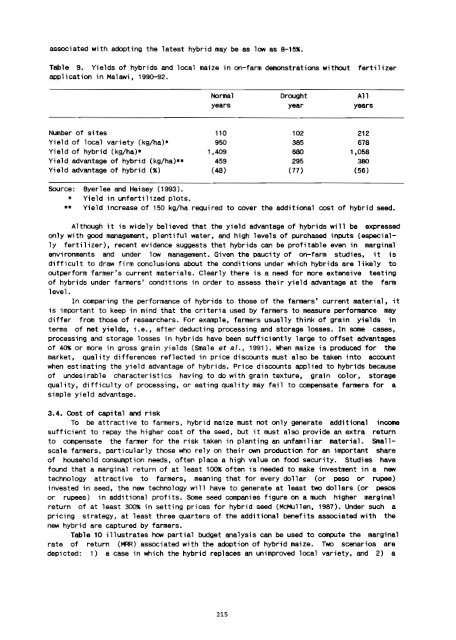Proceedings of the Fifth Asian Regional Maize Workshop - Search ...
Proceedings of the Fifth Asian Regional Maize Workshop - Search ...
Proceedings of the Fifth Asian Regional Maize Workshop - Search ...
Create successful ePaper yourself
Turn your PDF publications into a flip-book with our unique Google optimized e-Paper software.
associated with adopting <strong>the</strong> latest hybrid may be as low as 8-15~.<br />
Table 9. Yields <strong>of</strong> hybrids and local maize in on-farm demonstrations without fertilizer<br />
application in Malawi, 1990-92.<br />
Normal Drought All<br />
years year years<br />
Number <strong>of</strong> sites 110 102 212<br />
Yield <strong>of</strong> local variety (kg/ha)* 950 385 678<br />
Yield <strong>of</strong> hybrid (kg/ha)* 1,409 680 1,058<br />
Yield advantage <strong>of</strong> hybrid (kg/ha)** 459 295 380<br />
Yield advantage <strong>of</strong> hybrid (~) (48) (77) (56)<br />
SOUrce: Byerlee and Heisey (1993).<br />
* Yield in unfertilized plots.<br />
** Yield increase <strong>of</strong> 150 kg/ha required to cover <strong>the</strong> additional cost <strong>of</strong> hybrid seed.<br />
Although it is Widely believed that <strong>the</strong> yield advantage <strong>of</strong> hybrids will be expressed<br />
only with good management, plentiful water, and high levels <strong>of</strong> purchased inputs (especially<br />
fertilizer), recent evidence suggests that hybrids can be pr<strong>of</strong>itable even in marginal<br />
environments and under low management. Given <strong>the</strong> paucity <strong>of</strong> on-farm studies, it is<br />
difficult to draw firm conclusions about <strong>the</strong> conditions under which hybrids are likely to<br />
outperform farmer's current materials. Clearly <strong>the</strong>re is a need for more extensive testing<br />
<strong>of</strong> hybrids under farmers' conditions in order to assess <strong>the</strong>ir yield advantage at <strong>the</strong> farm<br />
level.<br />
In comparing <strong>the</strong> performance <strong>of</strong> hybrids to those <strong>of</strong> <strong>the</strong> farmers' current material, it<br />
is important to keep in mind that <strong>the</strong> criteria used by farmers to measure performance may<br />
differ from those <strong>of</strong> researchers. For example, farmers usually think <strong>of</strong> grain yields in<br />
terms <strong>of</strong> net yields, i.e., after deducting processing and storage losses. In some cases,<br />
processing and storage losses in hybrids have been sufficiently large to <strong>of</strong>fset advantages<br />
<strong>of</strong> ~ or more in gross grain yields (Smale et al., 1991). When maize is produced for <strong>the</strong><br />
market, quality differences reflected in price discounts must also be taken into account<br />
when estimating <strong>the</strong> yield advantage <strong>of</strong> hybrids. Price discounts applied to hybrids because<br />
<strong>of</strong> undesirable characteristics having to do with grain texture, grain color, storage<br />
quality, difficulty <strong>of</strong> processing, or eating quality may fail to compensate farmers for a<br />
simple yield advantage.<br />
3.4. Cost <strong>of</strong> capital and risk<br />
To be attractive to farmers, hybrid maize must not only generate additional income<br />
sufficient to repay <strong>the</strong> higher cost <strong>of</strong> <strong>the</strong> seed, but it must also provide an extra return<br />
to compensate <strong>the</strong> farmer for <strong>the</strong> risk taken in planting an unfamiliar material. Smallscale<br />
farmers, particularly those who rely on <strong>the</strong>ir own production for an important share<br />
<strong>of</strong> household consumption needs, <strong>of</strong>ten place a high value on food security. Studies have<br />
found that a marginal return <strong>of</strong> at least 1~ <strong>of</strong>ten is needed to make investment in a new<br />
technology attractive to farmers, meaning that for every dollar (or peso or rupee)<br />
invested in seed, <strong>the</strong> new technology will have to generate at least two dollars (or pesos<br />
or rupees) in additional pr<strong>of</strong>its. Some seed companies figure on a much higher marginal<br />
return <strong>of</strong> at least 30~ in setting prices for hybrid seed (McMullen, 1987). under such a<br />
pricing strategy, at least three quarters <strong>of</strong> <strong>the</strong> additional benefits associated with <strong>the</strong><br />
new hybrid are captured by farmers.<br />
Table 10 illustrates how partial budget analysis can be used to compute <strong>the</strong> marginal<br />
rate <strong>of</strong> return (MAR) associated with <strong>the</strong> adoption <strong>of</strong> hybrid maize. Two scenarios are<br />
depicted: 1) a case in which <strong>the</strong> hybrid replaces an unimproved local variety, and 2) a<br />
215

















